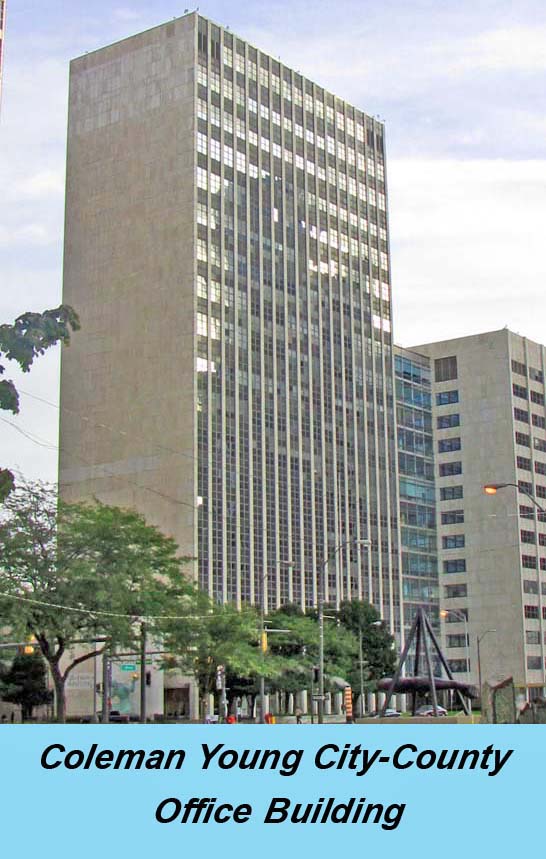

For much of the twentieth century, civic leaders and planners in Detroit intended to redevelop the downtown riverfront into an attractive location that would serve as a key point in the metropolis. Since the emergence of Great Lakes shipping in the nineteenth century, the riverfront had been lined with docks, rail lines, and silos for millers and cement companies. After World War II, changes were made. The heirs to the Dodge fortune contributed funds to assist in the development of Hart Plaza thereby replacing Nineteenth Century buildings and docks with an appealing open space. The Veterans Memorial Building was constructed on the south side of West Jefferson near the intersection of Jefferson and Woodward. The Ford Foundation and local Ford and Mercury dealers funded the building of the Ford Auditorium.
Very few, if any, buildings had gone up in downtown Detroit after the start of the Depression in October, 1929, but the city’s population and manufacturing activities boomed during World War I. Many different efforts were made after World War II to remove old buildings near the intersection of Woodward and Jefferson and replace them. In 1948, the Michigan legislature created a Detroit-Wayne County Building Authority to construct a major new office building for the city and county in downtown Detroit. They selected the location at the northeast corner of Jefferson and Woodward. Mariners Church, designed by Calvin Otis, had occupied that space since the early 1850s. That church was carefully moved across East Jefferson to its present location adjoining Hart Plaza and the Ford Auditorium.
Construction of the building you see began in 1951 and was completed in 1955. Architect and urban planner, Charles Edouard Jeanneret, was born in Switzerland in 1887, but living in France in his twenties, changed his name to Le Corbusier. He was trained as a watch engraver but traveled throughout Europe thinking about urban planning and analyzing architecture. He became a key figure in the development of modern design in the Twentieth Century, especially in the years after World War II. There was a sharp change from the types of buildings that were erected before the Depression and were different from what followed. You can compare the Le Corbusier-inspired City-County Building pictured here with Writ Rowland’s Guardian Bank Building—1929—or with the Michigan Gas Company Building that Minoru Yamasaki designed a just a few years after the City-County Building. Le Corbusier did not design this City-County Building but the architects—Harley, Ellington and Day—were influenced by the post-war popularity of Le Corbusier’s ideas. Indeed, Le Corbusier played a key role in the design of the United Nations Building in New York so that structure was, in a sense, an inspiration for Harley, Ellington and Day when they drew up plans for these two buildings. Their nearby Veterans Memorial Building is similar in style. Le Corbusie-inspired modernist building have large planes of stone, glass, concrete and stucco similar to the City-County Building. Perhaps they are meant to suggest sleek efficiency. Typically, the Le Corbusier buildings are tall and rectangular. Note that there are two structures that make up the City-County Building. There is the larger 20-story structure nearer the intersection of Woodward and Jefferson that was designed for use by city and county courts. Then there is a 14-story structure designed for use by city and county administrative offices.
I believe that this modernist architecture lost its popularity quite quickly. It has been called brutalist design. Critics charge Le Corbusier with creating the “New Brutalism.” There is very little in this City County structure to suggest any warmth or great artistic flair and no efforts were made by the architects to attract people into the building through pleasant spaces or appealing shops at the ground floor.
You might compare the totally functional and business-like ground floor of the City-County Building with the open glass-faced ground floor that Minoru Yamasaki designed for the Michigan Gas Company Building. Yamasaki also had his friend, Giaconda Mango, sculpt an attractive ballerina for the West Jefferson face of his building, Passo did Danza.
Perhaps, the most attractive aspect of the City-County Building at present is the impressive Spirit of Detroit statue that Marshall Fredericks designed and located on the west side of the building.
This structure was known until 1997 as the City-County Building. Following the 1997 death of Coleman Alexander Young, who served as Detroit’s mayor from 1974 to 1993, it was renamed in his honor.
If you are interested in urban planning and the future of Detroit, it interesting to think about the success or failure of efforts to revitalize downtown Detroit. At the end of World War II, Detroit leaders understood that there was a great opportunity to improve the city’s downtown and capitalize upon its potentially very attractive river front. In the following four decades, a great deal was accomplished within the one-half mile radius of the intersection of Jefferson and Woodward—Hart Plaza, the modernist Pontchartrain Hotel, Cobo Hall, the Veterans Memorial Building, the Ford Auditorium, the Michigan Gas Company building, the move across East Jefferson of Mariners Church and, most recently, the Renaissance Center. Were these efforts successful in terms of improving the ambiance of downtown, increasing commercial activity or generating of tax revenue?
Architects: Harley, Ellington and Day
Architectural style: International style influence by LeCorbusier
Date of Completion: 1955
Use in 2010: Municipal office building
City of Detroit Designated Historic District: Not listed
State of Michigan Registry of Historic Sites: Not listed
National Registry of Historic Places: Not listed
Photograph: Ren Farley: September 11, 2010
Description Prepared: January, 2010
Return to City Government
Return to Home Page